2009 Manhattan Hotel Market Overview Survey Result
Analysis
Respondents: Members of the Hotel Association of New
York City and the Greater New York Chapter of Hospitality Sales and Marketing
Association International
Prepared by Simone Baradei, Zheyi Chen, Rick Kelly, Yun Wang,
Robert Washington
This report presents the results and data analysis of the 2009
Manhattan Hotel Market Overview survey conducted by graduate students
of New York University’s Preston Robert Tisch Center for
Hospitality, Tourism, and Sports Management in collaboration with
HVS Global Hospitality Services. The survey was conducted in March
2009. The objective of this research is to identify hotel professionals’
perspective on the current recession and its impact on the New
York City hotel market specifically. It is also aimed at identifying
trends in the NYC hotel market as well as how hotels plan or are
planning to react to the effects of the current economic downturn.
An online survey was developed and targeted to members of the
Greater New York Chapter of the Hospitality Sales and Marketing Association
International (HSMAI) and the Hotel Association of New York City
(HANYC). The survey was sent to approximately 500 members of the
Greater New York Chapter of HSMAI. Of these members, 26 opted out of
taking the survey, 15 emails were invalid, and 10 members expressed
that they were not the appropriate contact to take the survey.
The HANYC database contained 240 email addresses, most of which
were for hotel general managers/executives. Of these members,
7 opted out of taking the survey and 19 emails were invalid. This
eliminated 77 names, resulting in a potential sample size of 663
members from HSMAI and HANYC.
Survey questions were limited to those related to changes, trends,
operations, and strategies currently utilized in today’s
NYC hotel market. The survey was also limited to 24 questions
to ensure a sufficient return rate; therefore, many questions,
though pertinent, were not included in order for the respondents
to complete the survey with the least amount of inconvenience.
New York University’s Preston Robert Tisch Center for Hospitality,
Tourism, and Sports Management and HVS Global Hospitality Services
thank all the respondents for their participation in this study.
SURVEY FINDINGS
The purpose of the survey is to gain perspectives relative to
trends in the hotel industry and their potential impact on the
New York City hotel market. Of the 137 responses, 68 were totally
completed, with the remaining 69 partially completed, representing
a 20.7% (includes both partial and fully completed surveys) response
rate. The findings outlined below are based on this 2009 Manhattan
Hotel Market Overview Survey.
The New York City hotel market continues its decline, and the
hotel professionals in the city displayed less optimism for this
year, 2009. Most respondents anticipated a decrease in their year-over-year
demand due to the fact that 86.3% of them expect a lower annual
occupancy in their hotels compared to 2008. 83.8% of the respondents
expect their hotel’s year-end ADR in 2009 to be lower compared
to 2008, 80.6% of whom anticipated a decrease of more than 10%.
More than 70% of the respondents believe that their RevPAR will
rebound at least after the first quarter of 2010. Lower demand
results in less revenue, and almost all respondents’ hotels
have contemplated taking actions to reduce operating expenses,
especially in cutting down their labor costs. In addition, to
drive more demand, more than 60% of the participating hotels have
discounted their room rates by more than 10% because of the current
recession.
Below are additional details of the survey findings. (The number
of responses to each question may vary, and the statistics are
based on responses to each individual question).
- In terms of job functions, more than three quarters of the
survey respondents were from General Management (37.0%) and Sales
& Marketing teams (39.3%). Revenue Management (8.9%), Operations
(2.2%), and Accounting/Finance (2.2%) made up 13.3% combined.
Other job functions (10.4%) included President of a hotel company,
Human Resource, Consultant, Asset Management, and so on.
- As to the hotel market segments, 21.7% of the respondents’
hotels belonged to the upscale market, 19.4% belonged to the luxury
market, and 18.4% was identified as upper upscale. A little more
than a quarter was midscale, some with F&B (14.7%) and some
without F&B (11.6%). Only 3.1% belonged to the economy hotel
market, and unaffiliated hotels counted for 10.9%.
- The areas of the respondents’ hotels varied, but about
three quarters (73.6%) of these hotels were Midtown properties,
with almost half (43.4%) located on the west side of Midtown.
The Upper East and West Sides combined accounted for 9.4%, and
17.0% were from the Downtown area.
- The majority of respondents’ hotels (63.3%) were affiliated
with a brand. Of those with a brand affiliation, 22.2% saw an
11% to 20% contribution from their brand reservation system. Approximately
17.5% saw a 31% to 40% contribution, 15.9% contributed less than
10%, and 17.4% of all respondents saw a contribution of over 40%.
- In terms of year-over-year (2008-2009) demand change, in the
leisure guest segment, slightly less than three quarters (74.0%)
of respondents expected a decrease in their year-over-year demand,
61.1% of which was a decrease of more than 10%. In the business
segment, around 85% of respondents anticipated a decrease in their
demand, three quarters of whom expected a decrease of more than
10%. In the meeting/group segment, around 50% anticipated a decrease
of more than 10% in their year-over-year demand. See Figure 1
below for details.
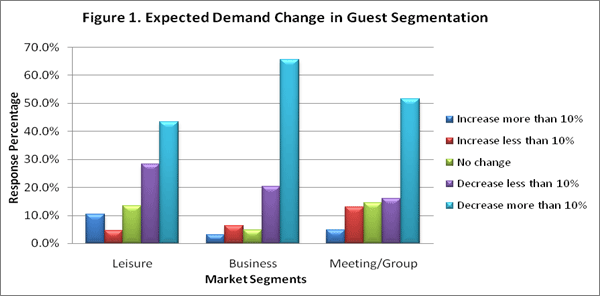
- In terms of marketing, about a half (43.1%) of the respondents’
hotels were decreasing their marketing budget in 2009 compared
to 2008. Roughly 31.9% have kept their budget the same, and a
quarter of them are increasing their marketing efforts.
- About half of the respondents reported a decrease in their
international leisure, business, and meeting/group travelers in
the past year. Less than 20% of all respondents reported an increase
in their domestic traveler profile in the leisure, business, and
meeting/group segments in the past year. Please refer to the chart
below for more details.
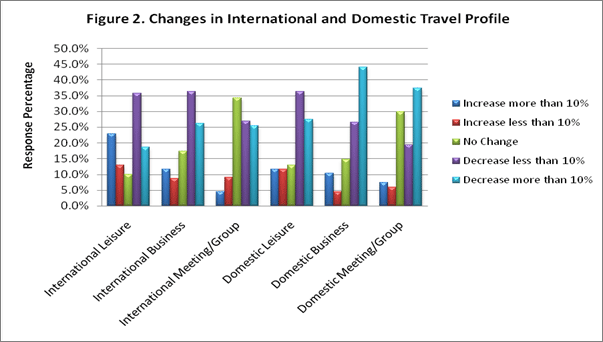
- Europe was identified as the strongest generator of international
travelers for most of the respondents’ hotels this year,
2009. About 89.3% of the respondents listed the United Kingdom
as the strongest generator of international travelers to their
hotel property. South America (38.7%), Canada (37.3%), and Germany
(30.7%) are three other major generators of international visitors
to respondents’ hotels. See Figure 3 for more information.
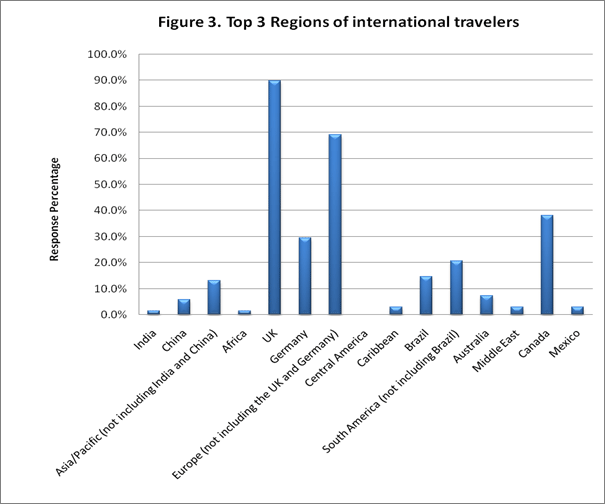
- In terms of occupancy, three quarters of all respondents expected
a lower annual occupancy at their hotels in 2009, while 12.5%
expected a higher annual occupancy, the same rate as those who
thought there would be no change in their hotels’ annual
occupancy. See Figure 4 for more detail.
- Of all the respondents, 79.5% expected their year-end 2009
ADR to be lower than year-end 2008, and of those respondents,
80.6% expected ADR to be lower by more than 10%. Only 16.7% of
all respondents expected a higher year-end ADR, and 3.8% expected
no change in their hotels’ ADR in 2009. Refer to Figure
4 for more statistics.
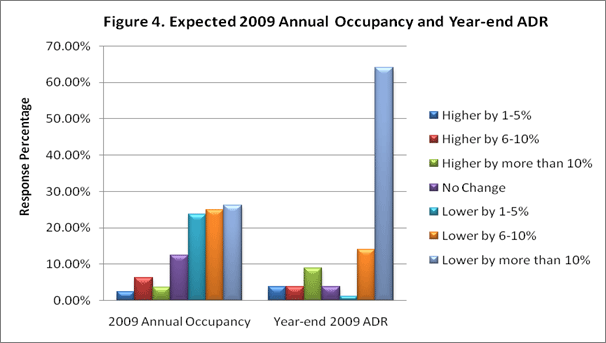
- Respondents were asked to rate factors in terms of their importance
to attract international guests to NYC hotels, using a scale of
1 to 5, with 5 having the greatest potential impact. Of all respondents,
70.6% considered price as having the greatest impact, receiving
an average rating of 4.53. Most respondents thought language and
cuisine to be less important. Language received an average rating
of 1.97, and cuisine received 1.81. Location was believed to have
a great impact, with an average rating of 4.25. Service quality,
brand recognition, and amenities were considered somewhat important,
receiving ratings of 3.55, 3.16, and 3.06, respectively.
- In terms of factors to attract domestic guests, price again
was thought to have the greatest impact, receiving an average
rating of 4.74. Location was also considered important, with an
average rating of 4.25. Service quality had an average rating
of 3.75, and brand recognition and amenities received 3.20 and
3.22, respectively. Cuisine was considered less important and
received 2.00.
- Almost all the respondents’ hotels have used discounting
of room rates to offset a decrease in occupancy this year. Approximately
91.8% of all respondents’ hotels have discounted their room
rates for leisure guests, with 65.3% discounting their room rates
by more than 10%. In the business segment, 97% of all respondents’
hotels have discounted their room rates, and 64.7% have discounted
their room rates by more than 10%. About 95.5% of all respondents’
hotels have offered discounts to the meeting/group segment, with
64.2% discounting their room rates by more than 10%. See Figure
5 for more details.
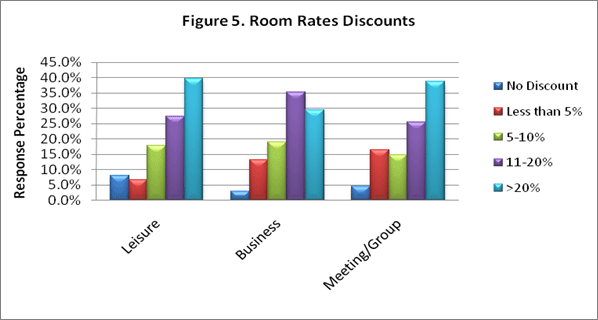
- As to the top three distribution channels in terms of their
contribution to hotel revenue, third-party websites received most
of the votes. Roughly 78.1% of all respondents rated third-party
websites as one of their top three revenue drivers, and 63.0%
rated their properties’ web sites to be one of the top three
distribution channels. About half of all respondents rated their
central reservation system (54.8%) and on-property reservation
system (50.7%) one of their top three revenue drivers. Travel
agencies and corporate websites received 37.0% and 16.4%, respectively,
of the votes. See Figure 6 for more information.
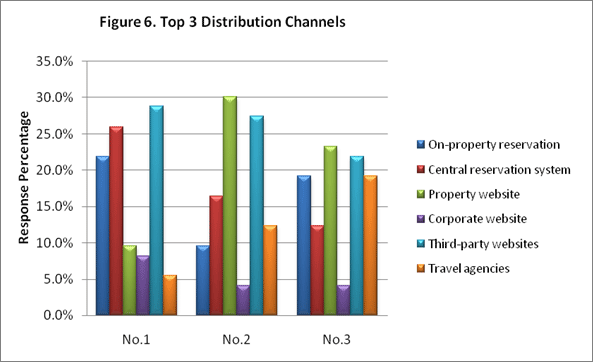
- 94.2% of the respondents’ hotels have contemplated taking
actions to reduce their operating expenses. Of those who had taken
or contemplated taking actions to reduce operating costs, approximately
75% consider(ed) reducing labor costs. Laying off staff, reducing
employee hours, freezing salaries, and reducing new hires received
80.9%, 77.9%, 75.0%, and 72.1%, respectively, of the votes. Of
all the respondents, 51.5% were also considering reducing employee
benefits and bonuses. About 33.8% reduced or intend to reduce
operating hours in their restaurants and spas to decrease operating
costs, the same percentage as those who considered reducing their
sales and marketing expenses. Deferring maintenance and reducing
training received 27.4% and 14.7%, respectively.
- Low demand for hotel rooms was considered to be a great challenge
for most hotels in 2009. Approximately 68.2% of all respondents
believed that decreased demand for hotel rooms will have the greatest
impact on their hotel operation in 2009 (average rating of 4.45,
1 to 5 scale). Decreased operating cash flow was also believed
to have a great impact (rating of 3.70). Changes in the make-up
of guest segments and a decrease in labor costs were considered
somewhat significant, with average ratings of 3.08 and 3.02, respectively.
Fluctuation of currency exchange rate, decrease in hotel maintenance,
increased cost of maintaining brand standards, and difficulty
in accessing credit were believed to have less impact on hotel
operations. Implementing green initiatives was thought to have
the least impact (rating of 1.92). Figure 7 shows a detail of
these statistics:
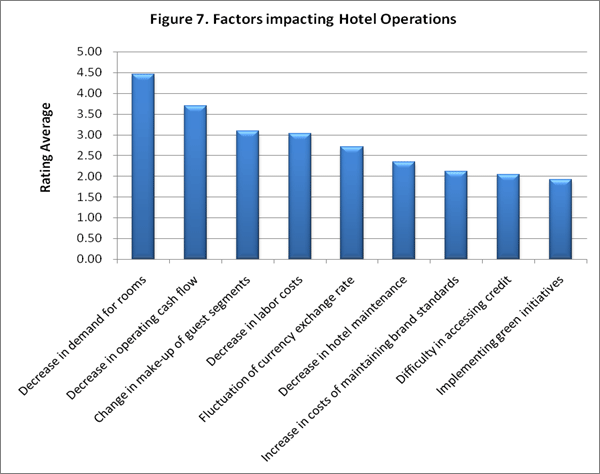
- Slightly less than three quarters (72.1%) of all respondents
expected their RevPAR to experience positive growth after 2009.
Only 27.9% were optimistic about year 2009. While 8.8% expected
their RevPAR to rebound in the third quarter of 2009, 19.1% believed
it would rebound in the fourth quarter of 2009. Approximately
57.4% of all respondents expected their RevPAR growth to occur
in year 2010, 46.2% of whom believed that their RevPAR will experience
positive growth in Q2 of 2010. About 10.3% of all respondents
were less optimistic, expecting a rebound of their RevPAR after
2010. See Figure 8 for more details.
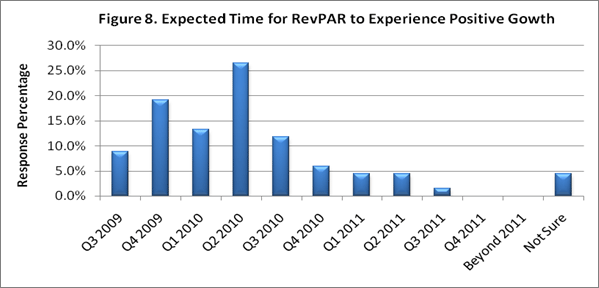
- Of all the respondents, 38.8% expected their RevPAR to return
to its 2nd half of 2008 level in the 2nd half of 2010, and 23.9%
expected this rebound to be realized in the 2nd half of 2011.
See Figure 9 for details.
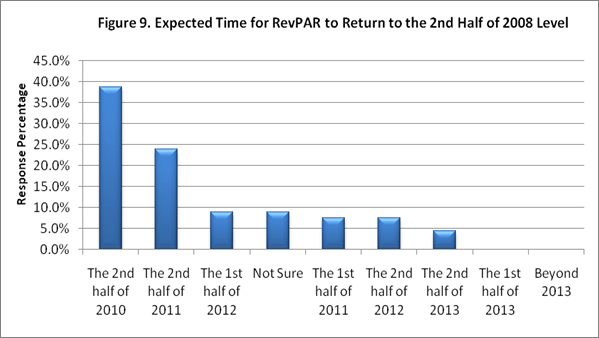
- 44.3% of all respondents ranked maximizing occupancy the most
important strategy for 2009, and 24.3% considered maximizing room
rate the most important. Maximizing operational efficiency ranked
third, at 20.0%, as the most important strategy of this year,
while 11.4% selected increasing return on marketing investment
to be the most important. See Figure 10 for details:
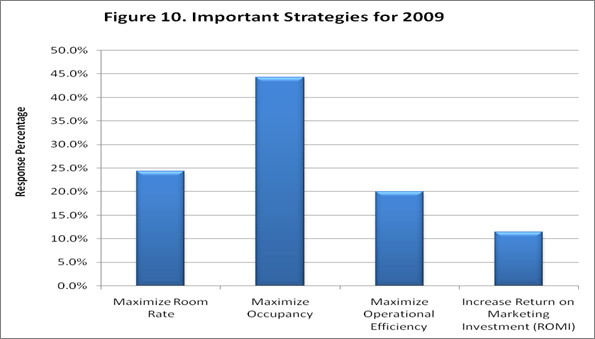
- When it comes to the impact of supply (12%-15% additional rooms
within the next two years), slightly less than a quarter, 24.6%,
of all respondents believed it would delay the City’s recovery
by twelve months. About 23.2% expected an eighteen-month delay.
See Figure 11 for more information:
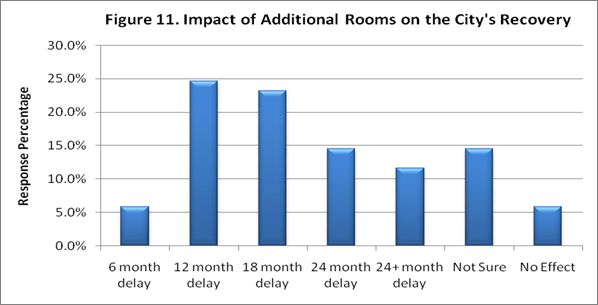
FURTHER ANALYSIS
Considering the respondent demographics, the NYU student team was
able to analyze various opinions derived from experienced professionals.
This analysis shed light on different perspectives of the Manhattan
hotel industry based on market segments, year-over-year comparison,
and job functions.
Market Segment Perspectives
- Half of the respondents from luxury hotel properties indicated
that their leisure customer base might decrease by more than 10%
in 2009. 87.5% of them indicated that their business segment might
decrease by more than 10%. 62.5% from luxury properties indicated
that their meeting/group customers might decrease by more than
10%.
- Half of the respondents from upper upscale properties anticipated
that the leisure segment would decrease by less than 10% in 2009.
76.9% of the participants anticipated that their business segment
might decrease by more than 10%. 41.7% of the respondents anticipated
that their business would decrease by more than 10%.
- 61.1% of the professionals from upscale properties anticipated
a decrease of more than 10% in the leisure segment. 66.7% of them
anticipated a decrease of more than 10% in the business segment.
66.7% anticipated a decrease of more than 10% in the meeting/group
segment.
- With regard to 2009 marketing budgets, half of the respondents
from luxury hotels would increase their marketing efforts, while
half would cut back. 53.8% of the respondents from upper upscale
hotels indicated no change compared to 2008. 44.4% of the professionals
from upscale properties anticipated a decrease in marketing efforts.
- All professionals from luxury, upper upscale, and upscale properties
indicated the UK as the strongest generator of international travelers
for their hotels in 2009.
- In 2009, luxury properties adopted the method of reducing new
hires to reduce their operating expenses. Upper upscale hotels
cut expenses by laying off staff, while upscale properties adopted
the strategy of laying off staff, reducing employee hours, and
freezing salaries.
- For luxury properties, more than 75% of all respondents forecast
a decrease in their year-over-year demand in the leisure, business,
and meeting/group segments. 85.7% of upper upscale hotel professionals
indicated decreased demand in the leisure segment; 100% anticipated
a decrease in the business segment and 66.7% anticipated a decrease
in the meeting/group segment. For upscale properties, around 85%
of the hotel professionals indicated a lower year-over-year demand.
- 87.5% of hotel professionals from luxury properties forecast
a lower annual occupancy in 2009; 75% expected a lower year-end
ADR. 76.9% of the upper upscale hotel professionals anticipated
a lower annual occupancy; 75% expected a lower year-end ADR. 94.7%
of respondents from upscale properties forecast a lower annual
occupancy; 94.4% expected a lower year-end ADR in 2009.
Year-over-year Comparison
The following analysis is a comparison between years 2009 and 2008
based on the Manhattan Hotel Market Overview survey results.
- 61.9% of all 2008 survey respondents expected an increase in
their year-over-year demand in their leisure segment, while the
2009 survey indicated that the majority (74%) of all respondents
expected a decrease in their leisure market.
- In the business segment, about 40% of all 2008 respondents
anticipated an increased demand, the same percentage as those
who expected a decreased demand, while 2009 respondents were less
optimistic in that market segment and 85% anticipated a decrease
in their year-over-year demand.
- In terms of the meeting/group segment, 67.2% of 2009 respondents
anticipated a decrease in this market, while only 20.4% anticipated
a decline last year and 40% forecast an increase in demand.
- As to marketing efforts, around half of all 2009 respondents’
hotels were decreasing their marketing budget with only a quarter
of them increasing their marketing budget, while in 2008, around
half of all respondents’ hotels increased their marketing
efforts and almost no hotels cut back this budget.
- The majority of 2008 survey respondents anticipated an increase
in their international travelers. However, about half of the 2009
respondents reported a decrease in their international travelers
in 2008. Europe remained the strongest generator of international
travelers, especially the United Kingdom, as indicated by both
surveys.
- Higher occupancy was expected by most of the 2008 survey respondents
(74.4%), while this year only 12.5% expected a higher annual occupancy.
Instead, three quarters of all respondents anticipated a lower
occupancy.
- With regard to ADR, the 2008 survey respondents were optimistic
as 100% expected their year-end 2008 ADR to be higher than year-end
2007; the 2009 survey showed the opposite as 79.5% expected their
year-end 2009 ADR to be lower than year-end 2008.
- Due to the additional room supply in the NYC hotel market,
84.2% of the respondents from the 2008 survey anticipated a decreased
occupancy in 2008. Consequently, around 80% of 2009 survey participants
believed that the additional room supply would delay the City’s
recovery.
- In terms of factors that affect hotel operations, the 2008
survey indicated that factors such as increase in energy cost,
increase in labor costs, economic uncertainty, and Customer Relationship
Management would have the greatest impact on hotel operations.
Low demand for hotel rooms, decreased operating cash flow, changes
in the make-up of guest segments, and decrease in labor costs
were considered as most significant factors impacting hotel operations.
General Management Perspective
Among the 50 General Managers, 64% were from upscale hotels and
above, 65.3% from brand-affiliated properties. 40% of the General
Managers’ properties were located in Midtown West.
- With regard to revenue contribution from brand reservation
systems, 83.3% of those who responded saw less than a 50% contribution.
29.2% saw a 31%-40% contribution. See Figure 12 for more details.
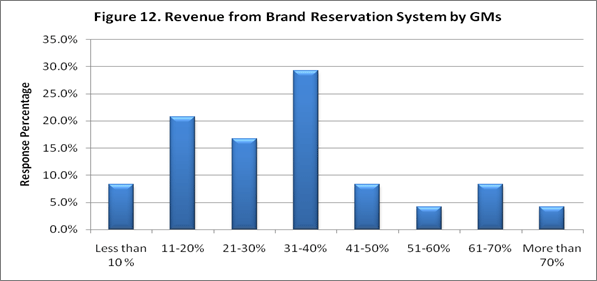
- For year-over-year (2008-2009) demand, 54.3% of all responding
general managers anticipated there would be a decrease in the
leisure segment of more than 10%. 70.6% anticipated a decrease
in the business segment of more than 10%. 63.6% anticipated a
decrease of more than 10% in the meeting/group segment. See Figure
13 for more details.
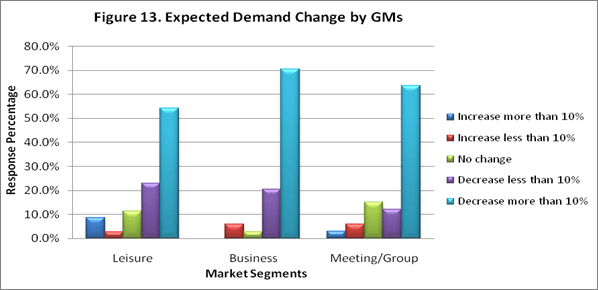
- Among the General Managers who answered the occupancy question,
76.9% expected their hotels’ 2009 annual occupancy to be
lower than that in 2008, with 80% expecting a decrease of more
than 6%.
- Most General Managers (80.0%) anticipated their hotels’
year-end 2009 ADR to decrease compared to that of last year, 85.7%
of whom predicted a decrease of more than 10%. See Figure 14 for
more details.
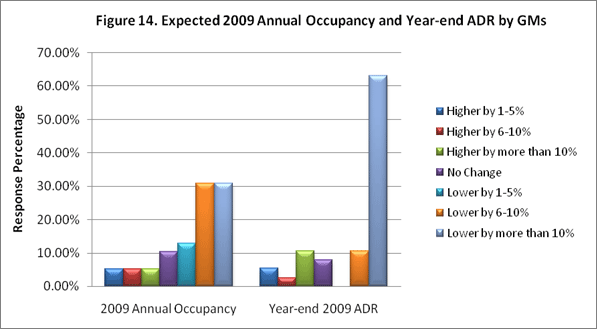
- 97.1% of the General Managers contemplated taking actions to
reduce operating expenses. Among the measures, laying off staff
and reducing employee hours were ranked as the most commonly used
(85.3%), followed by freezing salaries (76.5%) and reducing new
hires (73.5%).
- Among the factors that have impact on hotel operations, decreased
demand for rooms was the greatest factor, with a rating of 4.61
(5 has the greatest impact.)
- 45.5% of the General Managers anticipated RevPAR to return
to its 2nd half of 2008 level by the 2nd half of 2010.
- In terms of important strategies, maximizing room rate and
maximizing occupancy ranked 1st and 2nd, followed by maximizing
operational efficiency and increasing Return on Marketing Investment
(ROMI).
- Due to the increased room supply within the next two years,
84.8% participants anticipated that this addition of rooms will
delay the City’s recovery of more than 12 months.
Sales and Marketing Perspective
Among the 53 Sales and Marketing executives, 55% were from upscale
hotels and above, 54.5% from brand-affiliated properties. 48.6%
of their properties were located in Midtown West.
- With regard to revenue contribution from brand reservation
systems, 35.3% of Sales and Marketing professionals at brand-affiliated
properties who responded to this question saw less than a 10%
contribution, and 29.4% saw a contribution of 11%-20%. See Figure
15 for more details.
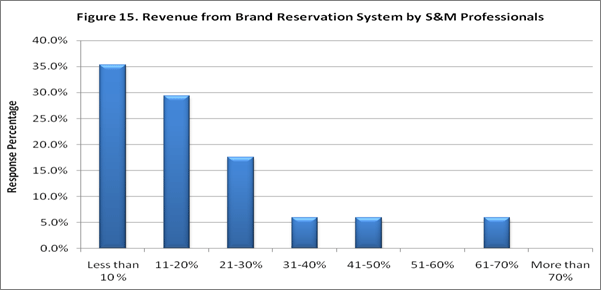
- For year-over-year (2008-2009) demand, 43.5% of those who responded
anticipated that there would be a decrease in the leisure segment
of more than 10%. 59.1% anticipated a decrease in the business
segment of more than 10%. 35.0% anticipated a decrease of more
than 10% in the meeting/group segment. See Figure 16 for more
information.
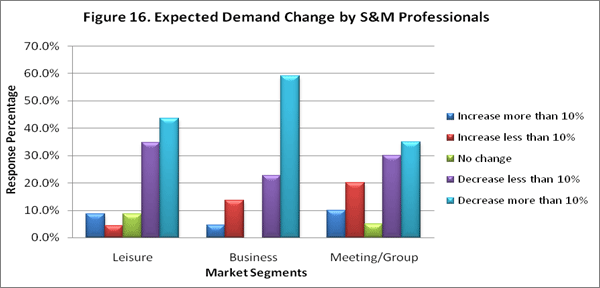
- 59.1% of the Sales and Marketing respondents expected their
hotel’s 2009 annual marketing budget to decrease.
- 76.9% of the participants predicted 2009 annual occupancy to
be lower than in 2008, and among these respondents, 45.0% expected
a decrease of more than 10%.
- Most Sales and Marketing professionals (83.3%) anticipated
their year-end 2009 ADR to decrease compared to that of last year.
Three quarters of those who anticipated a decline expected a decrease
of more than 10%.
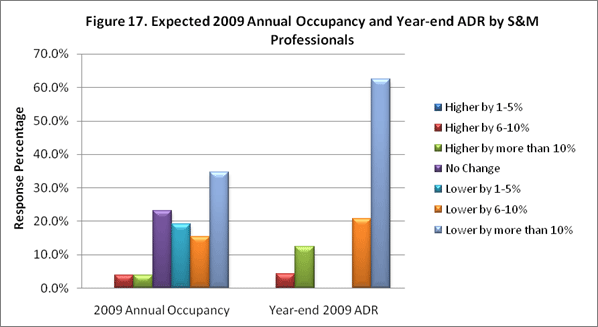
- 94.7% of the Sales and Marketing professionals contemplated
taking action to reduce operating expenses. Among the measures,
laying off staff (85.0%) was ranked as the most commonly used
(85.3%), followed by freezing salaries (80.0%) and reducing new
hires (65.0%).
- Among the factors that have an impact on hotel operations,
decreased demand for rooms was the greatest factor for 2009, with
a rating of 4.21, followed by decreased operating cash flow, with
a rating of 3.78 (5 has the greatest impact).
- 47.4% of the Sales and Marketing professionals anticipated
RevPAR to experience positive growth by the Second Quarter of
2010. A further 42.1% anticipated that RevPAR would return to
its 2nd half of 2008 level by the 2nd half of 2010.
- In terms of important strategies, maximizing occupancy ranked
1st (61.9%); maximizing room rate and maximizing operational efficiency
ranked 2nd (38.1%).
- Due to the 12%-15% increase in room supply in New York within
the next two years, 61.9% of participants anticipated that this
addition of rooms will delay the City’s recovery by more
than 12 months.
SUMMARY
This survey research has indicated that hoteliers are less optimistic
about the NYC hotel market given the current economic condition.
The general expectation from the respondents was that the NYC hotel
industry would experience a decrease in demand in all segments:
leisure, business, meeting/group. Most respondents from the Manhattan
hotel market expressed their concern that business would continue
to be challenging in 2009, even early 2010. Industry indices such
as RevPAR, ADR, and annual occupancy were anticipated to decrease.
A hotel’s success relies tremendously on market demand. Therefore,
this survey has determined that initiatives driving demand are the
priority for hotels desiring to develop their business in the near
future. To generate more profit in this tough economic time, increasing
revenue and reducing expenses are the most effective strategies.
Almost all hotels have contemplated taking or have taken actions
to reduce operating expenses.
This project will contribute to the NYC hotel industry by providing
a comprehensive understanding of how the economy impacts the hotel
industry – specifically, what potential challenges its professionals
may encounter and what operational strategies they may adopt. It
is also significant in identifying future trends and how these trends
will affect the NYC market specifically. In addition, the project
has provided valuable information on the NYC hotel market in 2009
and can serve as a reference for future research.
<<Previous
Next
>> |



